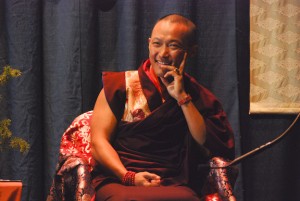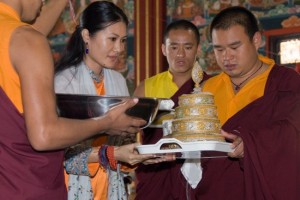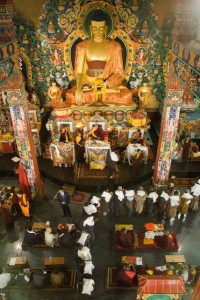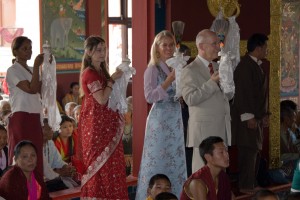Friday
Featured StoriesTenshuk Ceremony
Often people wonder what it means to have a teacher and to be a vajrayana practitioner. Even after we have been participating in this special relationship with our teacher and the phenomenal world for a long time, still we may wonder.
In this article, Walker Blaine engages this contemplation by offering an explanation of the Tenshuk Ceremony for Sakyong Mipham Rinpoche that is happening in Halifax on November 10. His comments encourage us to reflect on the importance of having a teacher, how fortunate we are to have such a relationship, and the preciousness of our teacher’s very life.
Walker shows us how we can all participate in the Tenshuk ceremony, whether we are near or far, a vajrayana practitioner or not, or are students of Sakyong Mipham Rinpoche or the Druk Sakyong, Chogyam Trungpa Rinpoche. He encourages us rally our resources – time, community, and generosity – to express our appreciation for the genuine kindness and leadership of our beloved Sakyong.
By Walker Blaine
The Kongma Sakyong Mipham Rinpoche is the living manifestation of the Rigden principle and the embodiment of the practice of warriorship. His presence gives meaning to the Shambhala teachings and the Shambhala community. Without him there would be no way to fully engage in the path of warriorship, no meaning to the teachings on creating enlightened society, and no way for our community to fully inherit the vajrayana dharma of India and Tibet. Not only is Sakyong Mipham Rinpoche the holder of the blessings of the Shambhala teachings, he also holds the Kagyu and Nyingma lineages, and is the tulku of Ju Mipham, one of the greatest teachers who revitalized the Nyingma tradition during the 19th century. For these reasons, and because of the Buddhist tradition of requesting teachers to remain and teach the dharma to benefit beings as long as possible, we make supplications for his well-being, longevity, and the fulfillment of his wishes.
Daily longevity chants are the main way we do this. On special occasions we make more elaborate supplications. At the end of major teachings it is customary to offer symbolic representations of body, speech, and mind to the teacher, both as a token of gratitude and as a request that a teacher remain with us for a long time. The most elaborate way to supplicate that someone teach and stay in good health is the tenshuk ceremony (Tib. brtan bzhugs). Ten means secure, stable, or firm, and shuk means to remain or live. Thus tenshuk means to secure or stabilize the life of the teacher. The tenshuk is a special opportunity for the entire community to strengthen the intention to abide in the atmosphere of devotion, loyalty, and basic goodness.
The condensed form of the tenshuk is performed using The Offering Chant for Presenting Representations of Body, Speech, Mind, Quality, and Action, and the long mandala offering liturgy. This is commonly practiced at the end of vajrayana teachings. The full form of the tenshuk ceremony includes those liturgies along with an elaborate offering of all the requisites for the kingdom of a dharma monarch, a longevity empowerment for the teacher, a long-life practice for the teacher, the ceremony to reverse the call of the dakinis, a feast, and aspiration prayers for peace and happiness in the world.
In general, when we request someone to do an important task, we offer things of value such as gold, a salary, a good meal, and so on. When we request someone to continue to teach, stay in good health, and lead a community as a dharma monarch, we symbolically offer whatever is needed for a dharma kingdom. This includes such things as a queen, a minister, a general, horses, elephants, food, wealth, and so on. Some of these offerings are symbolic and represent the qualities of enlightened rulership and an all-victorious kingdom.
Those who witnessed His Holiness Penor Rinpoche’s enthronement of the Sakyong in Halifax in 1995 watched the long procession of these offerings at the end of the ceremony. A similar display was presented to His Eminence Namkha Drimed Rinpoche earlier this year, in thanks for bestowing the Vidyadhara Chogyam Trungpa Rinpoche’s lineage of the Rinchen Terdzo upon the Sakyong in Orissa, India.
The complete tenshuk involves a longevity empowerment for the teacher coupled with a long life practice. This is because it is performed during critical junctures in a teacher’s life: times of obstacles, old age, sudden illness, or when a teacher has spoken directly about leaving this world. The tradition began after the passing of Shakyamuni Buddha, who had mentioned his approaching death three times to his attendant Ananda. Ananda had not realized this was an opportunity to request the Buddha to live longer, an unfortunate omission because a realized teacher is said to have the capacity to extend lifespan. After the Buddha passed into parinirvana the practice of supplicating for a teacher’s longevity was initiated.
On November 10th 2009, His Eminence Terton Namkha Drimed Rinpoche will bestow the tenshuk on Sakyong Mipham Rinpoche in Halifax, Nova Scotia, the heart of the Shambhala world. The greater Shambhala community will also have the chance to see His Eminence lead this rare ceremony online. The full form of the tenshuk is bestowed on the teacher by a realized master with whom the teacher has a close connection.
It is especially meaningful that His Eminence, the father of the Sakyong Wangmo and a student of Chogyam Trungpa Rinpoche with many connections to Shambhala and Gesar of Ling, is the one who will bestow the tenshuk. The event is also a major step forward in the development of our community. It is traditionally performed with the participation of only the vajrayana sangha, but in Shambhala the event will be open to everyone. His Eminence has performed the tenshuk for several eminent masters including His Holiness Penor Rinpoche, the Very Venerable Chatrul Rinpoche and the Venerable Karma Chagme Rinpoche.
The tenshuk is necessary at this time because the Sakyong is at a juncture in his life when according to both the Tibetan calendar and the interdependent relationship between his life and that of his father, obstacles may become present. According to the Tibetan astrological system, an individual may experience challenges at the end of every 12-year cycle in the same way that one can face difficulties during the last 10 days of any calendar year. Most Tibetans teachers go into retreat during these ‘obstacle years’ or keep their activities to a minimum. The Vidyadhara passed away during this cycle of his life. Because of the father-son relationship, the Sakyong has been advised to be extremely careful during the coming year so that any residual difficult karma carried from his father’s life may be pacified and averted.
A great deal has done in preparation for the event. In order to remove potential obstacles and pacify disharmony in the sangha His Eminence Namkha Drimed Rinpoche and lamas in India and the west have performed several intensive practices in the preceding months. His Eminence also has asked the Shambhala community to engage in practices to further purify the sangha and support the Sakyong during this time. The primary support for a teacher’s presence in the world is the genuine relationship with the students that results from devotion. The preparatory practices and the tenshuk itself are ways for the students to purify confusion and obstacles, and foster a deeper connection with the teacher.
A major feature of the tenshuk is the ceremony to reverse the call of the dakinis. This is an important offering and purification performed by the presiding master at the event. Dakinis are celestial beings who might call a teacher to another realm to teach the dharma, should the relationship with the sangha weaken. Such a ceremony will be done for a teacher who is extremely ill, as was the case toward the end of the life of the Vidyadhara Chogyam Trungpa Rinpoche. The practice is also part of the complete tenshuk because it is profound means of asking the teacher to remain with us. One aspect of reversing the call of the dakinis specifically focuses on improving harmony with the teacher by removing the obstacles resulting from damage to the teacher-student relationship. For students, the emphasis of this section of the tenshuk is to remove obstacles to harmony with the teacher and to develop the aspiration that the teacher’s life and activities be indestructible.
Supplication for the longevity of a teacher is one of the best ways to gather merit. It enables us to increase windhorse and develops the capacity to become of greater benefit to others. The tenshuk is our opportunity to do this in a vast way with the entire sangha, which in turn generates further windhorse. We do not supplicate the Sakyong for our benefit alone. We request him to live long and offer him the requisites to teach in order to benefit the entire Shambhala community and the world at large. The tenshuk embodies our wish for the fulfillment of the Sakyong’s role as protector of the earth. It expresses our aspiration for the swift realization of enlightened society, and the bodhisattva warrior’s aspiration for peace at this time of great stress and change on the planet.
For all these reasons, please join with the tenshuk as much as you are able. There are three major ways to participate:
1) The most important is practice. Please make aspirations for the Sakyong’s longevity, the fulfillment of his wishes for the community, and for obstacles affecting his activity to be removed.
2) The second way to join in is to attend the tenshuk either in person in Halifax, online as the ceremonies are broadcast, or through personal practice on the day of the event.
3) The final way to connect is to make an offering during the tenshuk. The reason for this is to make a connection between our own livelihood and that of the Sakyong at this point in his life. This could be a monetary offering or an offering of service, and it could include a gift connected with longevity, wealth, or anything that enables the Sakyong to fulfill his role in the world.
Making a direct connection between this moment in our lives and this juncture in the Sakyong’s life creates a specific link with the realization of Shambhala in our lifetimes. The more we create this connection in our minds and hearts, the more Shambhala is able to manifest through a Sakyong’s presence in this world.
Tenshuk offerings to Sakyong Mipham Rinpoche can be made in person at the ceremony in Halifax, or at tenshuk events at your local Shambhala center.
To register for the tenshuk, click here.
To make an offering through the Sakyong Ladrang, click here.
To learn more about traveling to the ceremonies, the Shambhala Congress and the Gesar Trakpo Abhisheka, click here.
To learn more about Shambhala, click here.
Many thanks to Their Majesties, Khenpo Gawang, Khenpo Tsering Gyurme, Lama Gyurme Dorje, and several friend-editors, for their help with this article.
Walker Blaine lives in Halifax, Nova Scotia. He authored the three-month Rinchen Terdzo blog (www.rinchenterdzo.org) and is a member of the Nalanda Translation Committee. His two CDs of dharma songs can be sampled at www.highlandeyes.com, on iTunes and on Rhapsody.
Rinchen Terdzo Photo Credits: Christoph Schoenherr





















Nov 10, 2009
Reply
Thank you Walker c.s. for this insightfull and clear article. Today will be a practice day, and walking will be walking offering mantra’s and so on. It rains here but the Sun shines.
Nov 9, 2009
Reply
Thanks for the clarifying explanation. It will heighten my interest and involvement when watching the Tenshuk ceremony online from the Amsterdam Shambhala Center.
Nov 8, 2009
Reply
Keith and I would love to be there in person but we will be forever with the Sakyong and CTR in spirit!
Nov 8, 2009
Reply
I’m looking forward to being present online and participating in local events. Thank you for the information.
May our Sakyong enjoy a long life and stay with to teach us for many, many years to come. Ki ki So so!
Nov 6, 2009
Reply
I’d like to practice in support of the Sakyong. Which practice is recommended. Shall we just do the longevity supplication?
Also, I don’t see any comment thread for this post– I’m leaving a comment partly in hopes of seeing other’s comments.